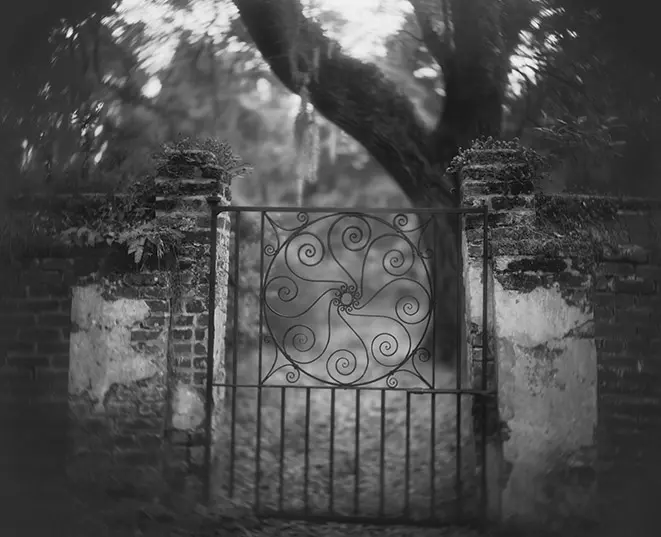TPG Golden Editions #11: Sally Mann
© Sally Mann, Courtesy Gagosian
South Carolina Gate, 2002
Archival Pigment Print
Edition of 25 with 5 Artist’s Proofs
17 x 20 inches
From £1,750 +VAT, unframed
“Working in the inexhaustible natural pageant before me, I came to wonder if the the artist who commands the landscape might in fact hold the key to the secrets of the human heart: place, personal history, and metaphor.”
Sally Mann, from her 2015 memoir, Hold Still
The eleventh release in TPG’s 50th Anniversary ‘Golden Editions’ series is this hauntingly beautiful image by American photographer Sally Mann (b.1951, Lexington, Virginia, US).
© Sally Mann, Courtesy Gagosian
South Carolina Gate, 2002
Archival Pigment Print
Edition of 25 with 5 Artist’s Proofs
17 x 20 inches
From £1,750 +VAT, unframed
Best known for her large-format, black-and-white photographs - at first of her young children, then later of landscapes - Sally Mann’s works utilize 19th century techniques and cameras. Exploring the complexities of familial relationships, social realities and the passage of time, she accentuates the tensions between nature, history and memory. Her images are deeply rooted in the myths and histories of the South, where she lives and works.
This poignant, quiet image of a gate at the entrance to a South Carolina cemetery invites contemplation of both the composition and the story that lies behind it. The eye is drawn to the wrought-iron spiral at the centre of the image, taken on Mann’s 8 x 10 inch camera and rendered beautifully using orthochromatic negative film. The graphic clarity of the ironwork anchors the blurred movement of its surrounds and sets off the soft curve of the tree and foliage so all elements appear in harmony. The delicate irregularities of the different photographic techniques Mann employs, often mirror the complexities that Mann finds in the landscape of the American South – a union of process and subject.
In 2010, The Photographers' Gallery hosted Mann’s first solo show in the UK, entitled The Family and The Land: Sally Mann. The exhibition drew from several of Mann’s series, including Immediate Family (1984-94), a series of intimate and revealing portraits of her three young children Emmett, Jessie and Virginia, and What Remains (2000-04), beautifully realised portraits of decomposing bodies returning to the land, taken at a research facility in Tennessee. The Family and The Land was the last exhibition held at Ramillies Street before the refurbishment of The Photographers' Gallery building began in 2010.
Born in Lexington, Virginia, Mann began to study photography in the late 1960s, attending the Ansel Adams Gallery’s Yosemite Workshops in Yosemite National Park, California and the Putney School and Bennington College, both in Vermont. She received a BA from Hollins College, Roanoke, Virginia, in 1974, and an MA in creative writing the following year. At a moment when many other photographers were creating large-scale color prints, Mann looked to photography’s past, investigating the visual and metaphorical potential of employing nineteenth-century technologies. She has long used an 8 x 10 bellows camera and has explored platinum, bromoil, and wet-plate collodion processes for making prints.
Mann had her first solo museum exhibition at the Corcoran Gallery of Art, Washington, DC, in 1977. Between 1984 and 1994 she worked on the series Family Pictures, which focused on her three children, then all under the age of twelve. From 1999 to 2012, Mann photographed Cy Twombly’s warmly lit studio in Lexington, recording the moments she spent with him there as well as the traces of his artistic life. From the late 1990s into the 2000s, Mann honed in on her relationship with the American South, taking photographs in Alabama, Mississippi, and Louisiana for her Deep South series (2005), as well as Civil War battlefields for Last Measure (2000). Her longtime interest in themes of death, time, and decay are also evident in What Remains (Bullfinch Press, 2003). In 2003, Mann began documenting the effects of muscular dystrophy on her husband, Larry, which would later become the Proud Flesh series (2009).
Mann’s latest large-scale project, A Thousand Crossings, further explores the complex cultural identity of the American South, as well as Mann’s relationship with her place of origin. The exhibition, which she began working on in 2006, debuted at the National Gallery of Art, Washington, DC in 2018 and has since traveled extensively in the United States and abroad in Paris.
A Guggenheim fellow and a three-time recipient of the National Endowment for the Arts fellowship, Mann was named “America’s Best Photographer” by Time magazine in 2001. Mann’s Hold Still: A Memoir with Photographs (Little, Brown, 2015) received universal critical acclaim; it was named a finalist for the 2015 National Book Awards and in 2016 won the Andrew Carnegie Medal for Excellence in Nonfiction.
